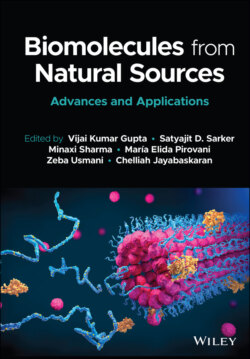Читать книгу Biomolecules from Natural Sources - Группа авторов - Страница 18
1.1.1.5 Biomedicine
ОглавлениеBiosurfactants show great potential in therapeutical applications, due to their biological activities. They have the great advantage of being mostly non-toxic and stable in extreme conditions. In particular the anti-microbial, and anti-biofilm properties of biosurfactants make them attractive agents for pharmaceutical and medical applications. Anti-bacterial properties of biosurfactants (Sana et al. 2018; Solaiman et al. 2016), anti-fungal (Sarwar et al. 2018), and anti-viral activities (Borsanyiova et al. 2016) have been reported.
Biosurfactants are well known by their membrane permeabilization properties as they can induce pore and ion channel formation in lipid bilayer membranes. Moreover, they are able to destabilize membranes disturbing their integrity and permeability. Also, pore formation in membranes may cause transmembrane ion influxes, including Na+ and K+, which result in membrane disruption and cell death (Fracchia et al. 2015; Matsumoto et al. 2016).
The anti-microbial property (Rodrigues et al. 2006) of the biosurfactant might be due to their capacity to disturb the integrity of the membranes, destabilizing them and leading to cell lysis by increasing the permeability of the membrane, leading to leakage of metabolites. This effect is based on the interruption of the protein conformation that signals important membrane functions leading to changes in the physical structure of the membrane (Banat et al. 2010; Cortés-Sánchez et al. 2013; Fracchia et al. 2015).
Biofilms describe groups of bacteria that colonize or accumulate on a given surface. They often contain bacterial strains that can become highly resistant. Biosurfactants can interfere with microbial adhesion and biofilm formation, by modifying the physicochemical properties of surfaces or changing bacterial interactions (Fracchia et al. 2015).
One example for a widely studied biosurfactant in the medical and pharmaceutical field is trehalose lipid. Studies have shown that trehalose lipid contains growth inhibiting properties against several resistant pathogen. Trehalose lipid (TL1) shows anti-fungal activity by which it inhibits the Chlamydospore germination of the fungus Glomerella cingulata at a concentration of 300 mg L-1. It also shows 30% inhibition of Candida albicans growth (Janek et al. 2018). Furthermore succinoyl-trehalose (STL-1 and -2) presents virucidal activity by inhibiting the herpes simplex virus and influenza virus at concentrations from 11–33 mg L-1. Trehalose lipids were investigated to present high anti-adhesive properties against several microorgansims, such as Candida albicans and Escherichia coli, on polystyrene surface and silicone urethral catheters, therefore it could be a promising coating agent (Janek et al. 2018; Kitamoto et al. 2002).
